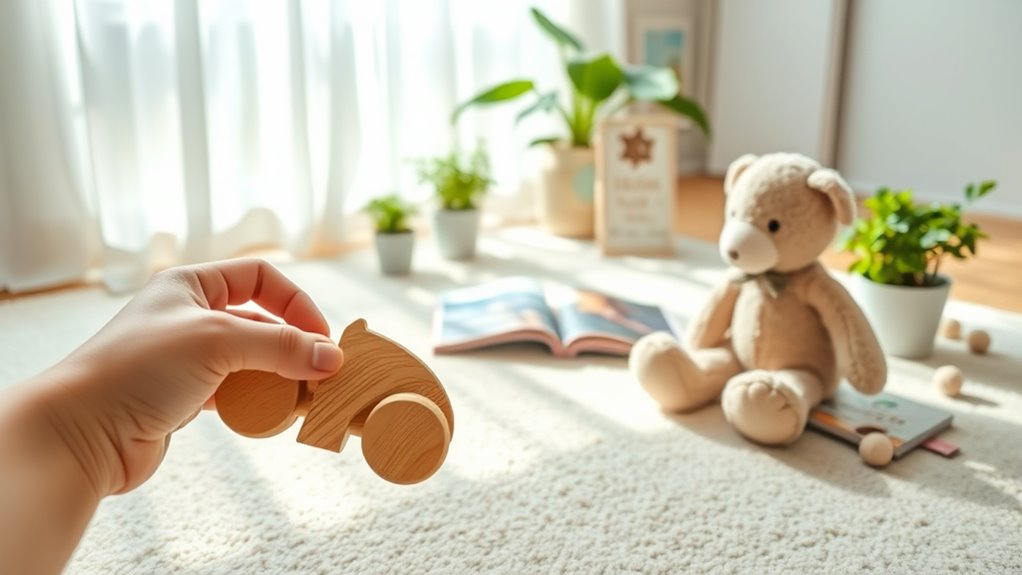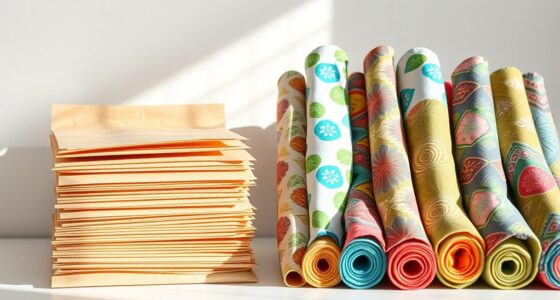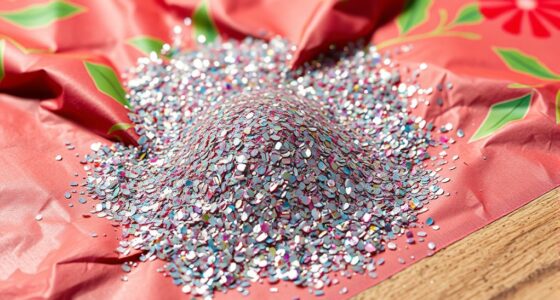To choose eco-friendly toys for your toddler, look for natural, non-toxic, and certified safe materials like organic wood or recycled plastics. Check for safety standards such as ASTM or EN71 to guarantee they’re free from harmful chemicals. Support brands with transparent supply chains and ethical manufacturing practices. Opt for durable toys that last longer and avoid excessive packaging. Continuing with your search will help you discover even more ways to make eco-conscious choices for your child’s playtime.
Key Takeaways
- Select toys made from natural, non-toxic, and recycled materials with eco-friendly certifications like FSC or Fair Trade.
- Prioritize durable, well-designed toys that promote longevity and reduce waste.
- Check safety standards and certifications to ensure toys are free from harmful chemicals and choking hazards.
- Support brands with transparent supply chains and ethical manufacturing practices.
- Avoid excessive packaging and single-use toys to minimize environmental impact.
Understanding What Makes a Toy Eco-Friendly

To understand what makes a toy eco-friendly, you need to look at the materials and manufacturing processes involved. First, consider how the toy impacts plastic pollution; eco-friendly toys often use sustainable or biodegradable materials to reduce environmental waste. Chemical safety is also essential, as harmful chemicals in plastics or paints can pose health risks to children. Eco-friendly toys are made with non-toxic, natural, or certified safe materials that don’t release toxic fumes or residues. You should also check if the manufacturing process minimizes pollution and energy consumption. Additionally, sustainable manufacturing practices ensure that the production of toys has a lower environmental footprint, promoting more responsible choices. By choosing toys that prioritize eco-conscious materials and safe production methods, you help reduce plastic pollution and protect your child’s health. This awareness guides you to make more responsible, sustainable choices.
Selecting Safe and Non-Toxic Materials
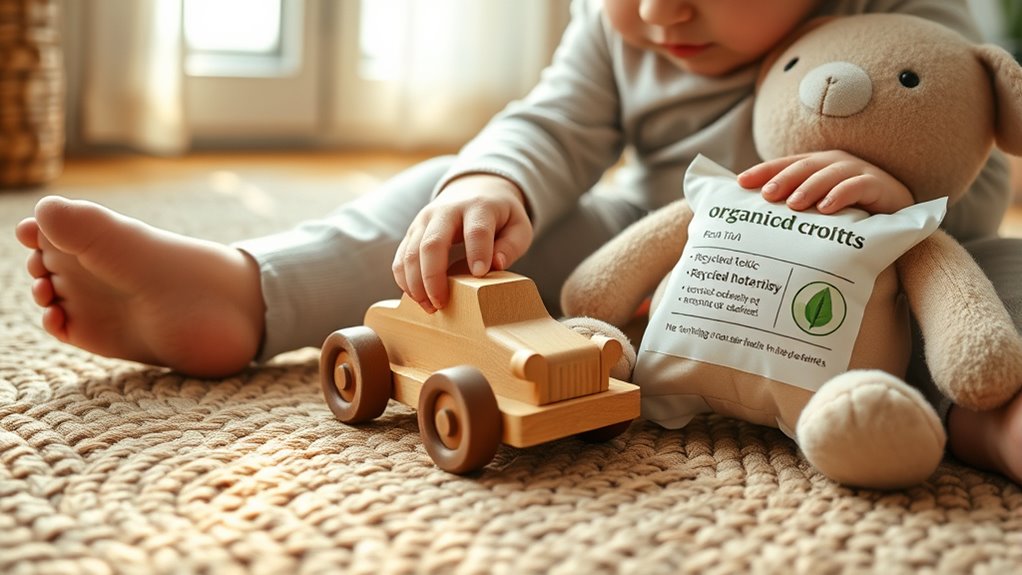
When choosing eco-friendly toys, prioritizing safe and non-toxic materials is essential for your child’s health. Look for toys made with non toxic paints, which are free from harmful chemicals and safe for little hands. BPA free plastics are another key feature, ensuring the plastic won’t leach toxins. To help you identify safe options, consider this quick guide:
| Material | Why It’s Safe |
|---|---|
| Non toxic paints | No harmful chemicals, safe for skin |
| BPA free plastics | No BPA, reduces toxin exposure |
| Natural wood | Free from synthetic chemicals |
Choosing toys with these materials minimizes health risks and supports an eco-friendly lifestyle. Always check labels and certifications to confirm safety standards.
Prioritizing Durable and Long-Lasting Toys
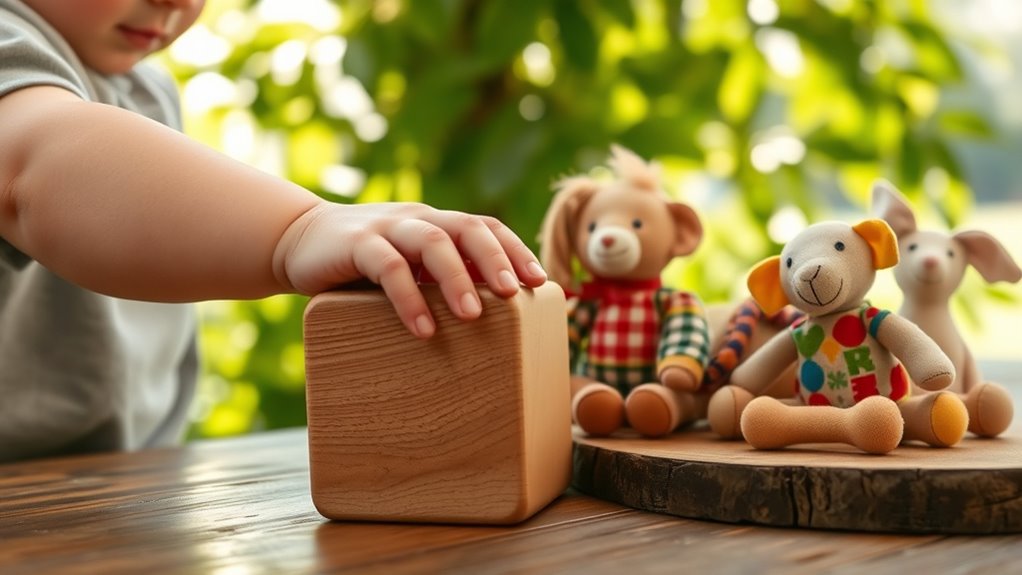
Choosing toys made from strong, high-quality materials guarantees they last longer and withstand rough play. Look for designs that are timeless and versatile, so they remain useful and engaging over the years. Prioritizing durability helps you reduce waste and make more eco-friendly choices. Incorporating long-term thinking into your selection process ensures that the toys continue to serve your child’s developmental needs over time. Additionally, selecting toys with robust construction can further ensure their longevity and safety during active play, especially when considering the impact of contrast ratio on visual clarity and durability.
Material Strength and Quality
Selecting toys made from strong, high-quality materials guarantees they can withstand daily play and last for years. Durable toys reduce the need for frequent replacements, which helps cut down on plastic pollution. When choosing eco-friendly options, check that the materials are safe and free from harmful chemicals. High-quality wood, bamboo, or sustainably sourced rubber often offer better chemical safety than cheaply manufactured plastics that may leach toxins. Ensuring the toy’s material is sturdy also means it won’t break easily, reducing choking hazards and waste. Look for certifications or labels indicating the toy meets safety standards. Material performance is crucial because it directly influences the toy’s durability and safety. Investing in well-made, eco-conscious toys not only supports your child’s safety but also contributes to a healthier planet by minimizing waste and chemical exposure. Additionally, selecting toys with material strength and quality can enhance their longevity and safety, making them more sustainable choices overall.
Timeless Design and Function
Durability and timeless design go hand in hand when it comes to eco-friendly toys that stand the test of time. Choosing toys with creative aesthetics ensures your child stays engaged, while their timeless appeal guarantees longevity. Look for simple, classic shapes and neutral colors that won’t go out of style, making the toy versatile for future generations. High-quality craftsmanship and durable materials mean your toy will withstand rough play without breaking or fading. Prioritizing function alongside design ensures the toy remains useful and entertaining over the years. Incorporating Vetted – Grace for Life Designs into your selection process helps ensure you’re choosing high-quality, eco-friendly options. By selecting long-lasting toys with a timeless look, you reduce waste and avoid the cycle of frequent replacements. This thoughtful approach helps you invest in quality, eco-friendly options that nurture your child’s development and respect the planet. Incorporating Best Beaches into your planning can also inspire outdoor activities that complement eco-conscious play at home.
Checking for Certifications and Safety Standards

How can you guarantee that the eco-friendly toys you pick are truly safe? Start by checking certification verification. Look for labels from reputable organizations that confirm the toy meets safety standard compliance, such as ASTM, EN71, or CPSIA. These certifications ensure the toy has been tested for harmful chemicals, choking hazards, and durability. Don’t rely solely on attractive packaging or eco-friendly claims; verify that the toy adheres to strict safety standards. This step helps you avoid products that might look safe but haven’t undergone proper testing. Always research the certification origin and validity. Additionally, understanding safety standards can be essential if the toy involves aquatic elements or is intended for use in or around water. Being aware of certification verification can help you make informed decisions about product safety. By prioritizing certification verification and safety standard compliance, you can confidently choose eco-friendly toys that are safe, sustainable, and suitable for your toddler.
Considering the Manufacturing Process and Supply Chain

Understanding the manufacturing process and supply chain behind eco-friendly toys helps guarantee you’re making truly sustainable choices. Look for brands that prioritize manufacturing ethics and supply chain transparency, ensuring fair labor practices and environmentally responsible sourcing. To visualize this, consider the following:
| Aspect | Key Consideration | Impact |
|---|---|---|
| Manufacturing Ethics | Fair wages, safe working conditions | Supports social responsibility |
| Supply Chain Transparency | Traceability of materials | Ensures authenticity and accountability |
| Material Sourcing | Local, eco-friendly suppliers | Reduces carbon footprint |
| Production Practices | Minimal waste, eco-friendly processes | Less environmental harm |
Additionally, evaluating the transparency of the supply chain can help confirm the authenticity of eco-friendly claims. Recognizing the cultural significance of materials can also guide consumers toward more meaningful and sustainable choices. Understanding the supply chain can further ensure that the entire process aligns with ethical and environmental standards.
Choosing Toys Made From Recycled or Sustainable Materials

Building on the importance of transparency and ethical practices in manufacturing, selecting toys made from recycled or sustainable materials further guarantees your choices support environmental health. Look for toys crafted from recycled plastics, which reduce waste and lessen demand for new raw materials. Bamboo toys are another excellent option—they grow quickly and require minimal resources, making them a sustainable choice for your toddler. When shopping, check labels for certifications indicating the use of recycled or eco-friendly materials. Choosing these toys not only minimizes your child’s exposure to harmful chemicals but also promotes resource conservation. Incorporating natural materials in toy selection aligns with Waldorf principles that emphasize creating a nurturing environment with safe, wholesome toys. By prioritizing recycled plastics and bamboo toys, you’re helping reduce environmental impact and encouraging sustainable production practices. Additionally, selecting secure payment options reduces cybersecurity threats and protects your transactions, ensuring a safer shopping experience. Engaging in sustainable consumer habits further amplifies your positive impact on the planet, fostering a healthier environment for your little one’s future.
Avoiding Single-Use and Excessively Packaging Toys
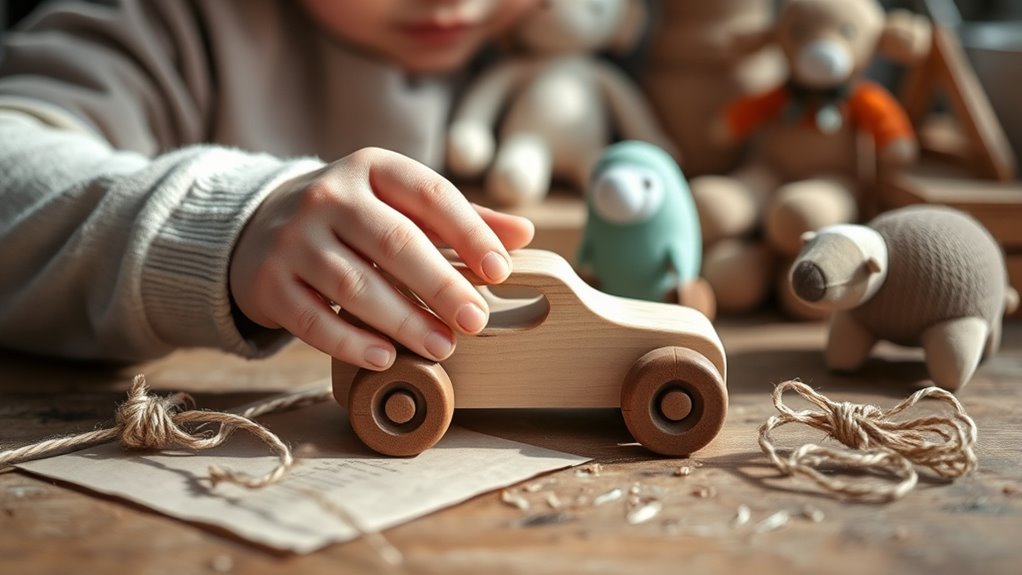
You can reduce waste by choosing toys with minimal packaging. Look for durable options that last longer and won’t need frequent replacements. This way, you’ll help cut down on single-use items and excess waste. Additionally, selecting products with sustainable materials can further lessen environmental impact. Opting for toys that are compact and easy to store also minimizes clutter and packaging needs. Choosing toys with eco-friendly manufacturing processes can support environmentally conscious production practices as well.
Choose Minimal Packaging
Opting for toys with minimal packaging helps reduce waste and lessen environmental impact. Look for products that emphasize minimal packaging and prioritize eco friendly labeling. These toys often arrive with less cardboard, plastic, and unnecessary wrapping, which means less trash for landfills. By choosing items with simple, straightforward packaging, you support manufacturers committed to sustainability. Check the label for eco friendly symbols or certifications that indicate environmentally conscious practices. Not only does this help cut down on plastic waste, but it also encourages brands to rethink packaging designs. Sustainable packaging practices can also drive innovation toward more eco-conscious solutions. Additionally, selecting toys with safe and durable materials ensures they are long-lasting and reduce the need for frequent replacements. Incorporating clarity of information about packaging sustainability can further empower consumers to make eco-friendly choices.
Opt for Durable Toys
Choosing durable toys means investing in items that can be enjoyed for years, reducing the need for frequent replacements. Durable toys often feature high-quality construction and safe materials that meet toy safety standards, ensuring your toddler’s safety during play. Look for eco labels on packaging, which indicate the toy’s eco-friendly manufacturing practices and materials. These labels help you identify products made from sustainably sourced or non-toxic materials, supporting your eco-conscious choices. Opting for well-made toys minimizes waste and lessens the environmental impact associated with single-use or cheaply made options. By selecting durable, safe toys, you also encourage your child’s development and curiosity while making a responsible, eco-friendly decision. This approach benefits both your child’s safety and the planet. Additionally, practicing mindful selection can foster a greater awareness of environmental issues from an early age, aligning with creative practice principles that emphasize intentionality and learning through experience.
Supporting Brands With Transparent Sustainability Practices

Supporting brands that demonstrate transparent sustainability practices is essential when selecting eco-friendly toys. Look for companies that openly share their environmental impact and hold eco labels verifying their claims. These labels, such as FSC or Fair Trade, show the brand’s commitment to responsible sourcing and eco-conscious manufacturing. Transparent brands often provide detailed information about their supply chains, materials, and efforts to reduce waste. This transparency helps you make informed choices, ensuring the toys you buy are genuinely eco-friendly. By supporting these brands, you encourage sustainable practices across the industry and reduce your child’s exposure to harmful chemicals or unsustainable resources. Prioritizing transparency not only benefits the environment but also promotes ethical production, giving you peace of mind with every purchase.
Incorporating Natural and Sensory Play Elements
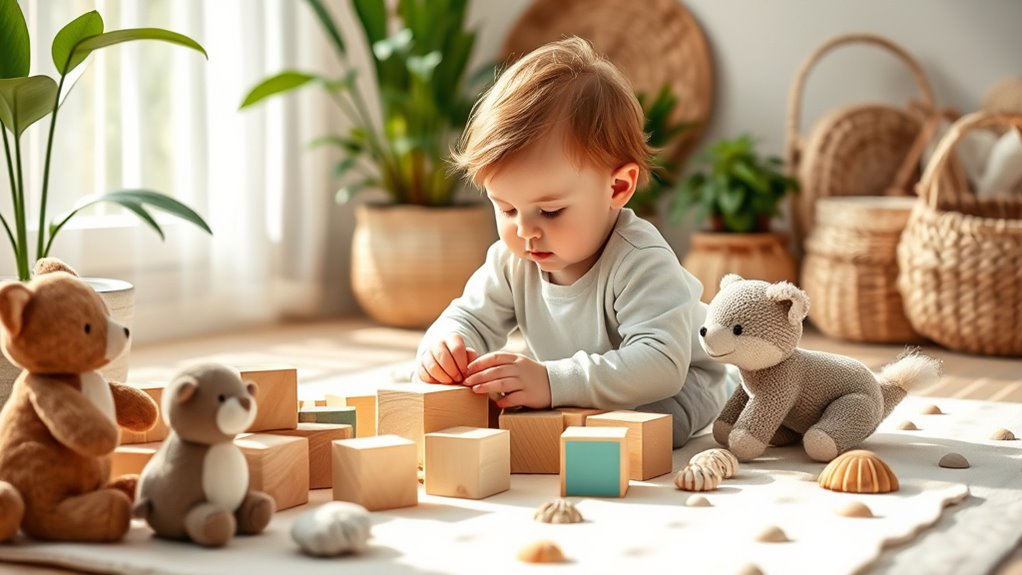
Have you considered how natural and sensory play elements can enrich your child’s development? Incorporating items like wooden blocks and fabric dolls encourages hands-on exploration and stimulates their senses. Wooden blocks, with their varied textures and weights, help develop fine motor skills and spatial awareness. Fabric dolls, often made from natural fibers, promote nurturing behavior and sensory engagement through different fabrics and textures. These toys are free from harmful chemicals and plastics, making them safer for your toddler and better for the environment. By choosing natural materials, you foster creativity and sensory awareness while minimizing exposure to synthetic substances. Incorporating these elements into play promotes healthy development and aligns with your eco-friendly values.
Frequently Asked Questions
How Can I Identify Truly Eco-Friendly Toy Brands?
To identify truly eco-friendly toy brands, look for companies committed to sustainable manufacturing and ethical sourcing. Check labels for certifications like FSC or GOTS, which indicate responsible practices. Research brands that openly share their supply chain details and use eco-friendly materials. Avoid brands with vague claims or lacking transparency. By focusing on these factors, you guarantee the toys you choose support environmental health and ethical labor practices, making a positive impact on your child’s world.
Are There Affordable Eco-Friendly Toy Options for Toddlers?
You’ll find plenty of affordable eco-friendly toy options for toddlers by exploring budget-friendly choices like wooden toys, handmade items, or those made from recycled materials. Look for brands that prioritize sustainability without high price tags. Cost-effective options often include simple, natural toys that promote creativity and are safe for your child. With a bit of research, you can discover eco-conscious toys that fit your budget and support your child’s development.
How Do Eco-Friendly Toys Support My Child’s Development?
Eco-friendly toys support your child’s development by enhancing sensorial experiences and motor skills. When your toddler plays with natural, non-toxic materials, they explore textures, sounds, and shapes, boosting their sensory growth. These toys encourage active movement, helping improve coordination and fine motor skills. By choosing eco-friendly options, you’re also teaching your child about sustainability and caring for the environment from a young age, fostering a well-rounded developmental foundation.
Can Eco-Friendly Toys Be Suitable for Children With Allergies?
You’ll find eco-friendly toys can be suitable for children with allergies when they’re made from hypoallergenic materials and carry non-toxic certifications. These features help minimize allergic reactions and guarantee safety. Always check labels to confirm the toy’s materials are free from common allergens and toxins. By choosing certified non-toxic and hypoallergenic options, you create a safer, healthier environment for your child while supporting eco-friendly practices.
What Are the Best Ways to Recycle or Repurpose Old Toys?
You can recycle or repurpose old toys by donating them to charity organizations, giving them a second life through toy donation. Additionally, try DIY toy repurposing to transform items into new, creative projects. For example, turn old puzzle pieces into wall art or use plastic containers for storage. These methods help reduce waste, extend the toys’ lifespan, and promote sustainability while keeping your space organized and eco-friendly.
Conclusion
By choosing eco-friendly toys, you’re planting seeds of kindness and sustainability in your child’s world. Think of each thoughtful selection as watering a tiny sapling that will grow into a mighty tree of awareness and care. Your choices ripple outward, shaping a greener future one playtime at a time. Together, you and your little one can nurture a garden of values, where love for the planet blossoms with every safe, sustainable toy you bring home.
